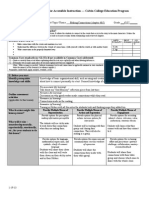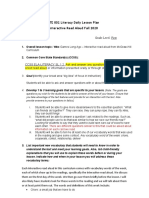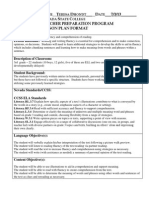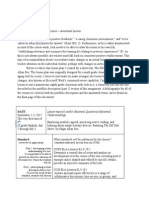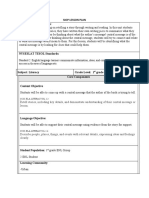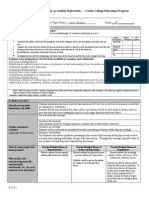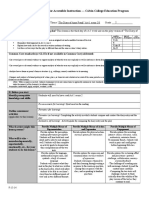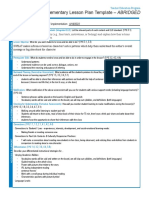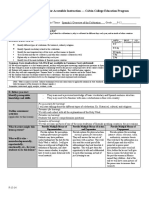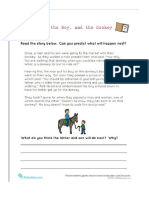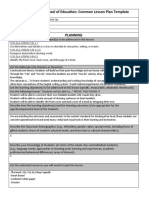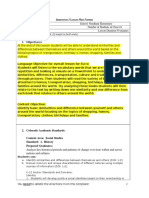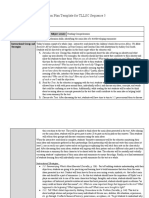Nonfictionlesson 2
Nonfictionlesson 2
Uploaded by
api-300765248Copyright:
Available Formats
Nonfictionlesson 2
Nonfictionlesson 2
Uploaded by
api-300765248Original Title
Copyright
Available Formats
Share this document
Did you find this document useful?
Is this content inappropriate?
Copyright:
Available Formats
Nonfictionlesson 2
Nonfictionlesson 2
Uploaded by
api-300765248Copyright:
Available Formats
Lesson Planning Form for Accessible Instruction Calvin College Education Program
Teacher
Silvia SuchecMrs. Noordewiers Class
Date
Subject/ Topic/ Theme Non-Fiction Books
Grade _______4_______
I. Objectives
How does this lesson connect to the unit plan?
This lesson will show students that non-fiction texts come in different styles such as magazines, workbooks and
pamphlets and not just books.
cognitiveR U Ap An E C*
Learners will be able to:
compare and contrast different texts
Identify certain aspects of the text(s)
Apply what they learned/read in a discussion
physical
development
socioemotional
An
An
Ap
Common Core standards (or GLCEs if not available in Common Core) addressed:
CCSS.ELA-LITERACY.RI.4.1
Refer to details and examples in a text when explaining what the text says explicitly and when drawing inferences from the text.
CCSS.ELA-LITERACY.RI.4.5
Describe the overall structure (e.g., chronology, comparison, cause/effect, problem/solution) of events, ideas, concepts, or
information in a text or part of a text.
(Note: Write as many as needed. Indicate taxonomy levels and connections to applicable national or state standards. If an objective applies to particular learners
write the name(s) of the learner(s) to whom it applies.)
*remember, understand, apply, analyze, evaluate, create
II. Before you start
Identify prerequisite
knowledge and skills.
Basic understanding of reading comprehension.
Ability to analyze texts.
Pre-assessment (for learning): Ask questions that prompt what they are about to do in this lesson.
Outline assessment
activities
(applicable to this lesson)
Formative (for learning): go over what the students gathered form the text. use terms like underline, bold,
heading to see if they find a pattern.
Formative (as learning): students will compare what they wrote on their KWL before the unit and add more to it
after theyve learned.
Summative (of learning):
What barriers might this
lesson present?
What will it take
neurodevelopmentally,
experientially,
emotionally, etc., for your
students to do this lesson?
1-19-13
Provide Multiple Means of
Representation
Provide options for perceptionmaking information perceptible
Each student gets a text to look at
and flip through. No need to share-very accessible
Provide Multiple Means of Action
and Expression
Provide options for physical actionincrease options for interaction
Provide Multiple Means of
Engagement
Provide options for recruiting
interest- choice, relevance, value,
authenticity, minimize threats
Allow students to share what they
find in their texts with one another
first. Compare them and bring it
into discussion.
Provide options for language,
mathematical expressions, and
symbols- clarify & connect
language
Provide options for expression and
communication- increase medium
of expression
Allow them to decipher why
certain words are underlined or
in bold. Take some time
thinking of the word text
Provide options for comprehensionactivate, apply & highlight
Have students make
connections to
American/Michigan history.
Show them how these kinds of
texts may benefit them in the
future.
Materials-what materials
(books, handouts, etc) do
you need for this lesson
and are they ready to
use?
Provide options for sustaining
effort and persistence- optimize
challenge, collaboration, masteryoriented feedback
Students will be sharing what
they know about nonfiction
with one another, they will
share aspects of their assigned
text and teach each other.
Provide options for executive
functions- coordinate short & long
term goals, monitor progress, and
modify strategies
Provide options for self-regulationexpectations, personal skills and
strategies, self-assessment &
reflection
The Mitten pamphlet on The Northwest Ordinance, various Michigan History for Kids magazines,
Great Smoky Mountains Encyclopedia booklet, The Midnight Ride of Sybil Ludington booklet. These
are ready to use.
Groups of 4 or 5. Arrange desks into circles or grouped in general.
How will your classroom
be set up for this lesson?
III. The Plan
Time
Components
Motivation
(opening/
introduction/
engagement)
Development
(the largest
component or
main body of
1-19-13
Describe teacher activities
AND
student activities
for each component of the lesson. Include important higher order thinking questions and/or
prompts.
Discussion questions:(1) how do we find
Students answer discussion questions: (1)
information? (2) Are books the only kind of
informational texts, books in general. (2) students
informational texts? (3) What can we learn from
try to think if information texts come in forms other
informational texts? (4) what do i mean when I say than books. (3) Students think of what they can
the wordtext?
learn...about historical events, animals, science
(4) Anything that may be written down, meant to be
read.
I have a variety of different texts that I want us to
look at...everyone in your group will have a
different text...youll notice that some of them
might be very different from others, or one may be
extremely different. Flip trough your text and take a I could have the class contribute other book
look a different characteristics that make your text
characteristics to look at. Can anyone give me any
unique. Are there words highlighted in bold? Take
other general characteristics that may be different
note of the illustrations. What genre do you think it between these texts? However, I dont want them
falls under? What is it about/what is the main
to go into specifics about their individual book at
idea?
this time because we will be discussing this later.
Now the various texts will be distributed as well as
post-it notes. Every person in each group will have
a different text to explore. Once they get these I
will ask a student or two what they are supposed to
the lesson)
be doing, so that the directions are reiterated. (The
classroom should be quiet, everyone is working
independently.)
Students will get at least 10 minutes to look
through their texts. They will record the title on the
post-it note as well as something they notice about
the text.
In the meantime I will be walking around the room,
making sure students are on task, guiding the few
that need more one on one. I will be asking some
questions to individual students to prompt them for
what I will be asking as a whole group when we
come together. What can you tell me about your
text? Whats it about? Does anything stand out to
you?..etc. I will remind all students to record on
their post-it notes.
After about 6-8 minutes I will have them rotate
their texts. Pass your text to the person on your
right. And now do the same thing they will look at
three texts in total (rotate twice) They should keep
the same questions in mind when looking at the
different texts. * Use a new post-it note to record
findings. I will either give them a paper with the
questions so it is easily accessible or write them on
the whiteboard.
After they have gotten to see three different texts,
depending on how much time we have, Id like for
them to discuss in smaller groups about the texts
and any differences they saw. If the groups are
struggling to stay on task, I will bring them back to
discuss it as a whole class.
Ultimately, we will open this up into a group
discussion. Sharing what we found regarding the
questions we began with.
I will have a chart up on the hover-cam and
everyone will have a copy of the chart as well. We
will take notes on all of the texts together. Chart
will be a basic four squares. Each square
representing a text, and we will fill it according to
comments the students share.
**One thing that may be tricky, if I have them look
at three different texts, they may not remember
what they discovered as well as if they only looked
at one and shared differences with their
neighbors**
ASK: In what regards would you use a few of these
texts? We have a biography, what good does that do
us? What about the others?
1-19-13
There are many wonderful kinds of informational
texts and it is so important we learn how to read
Closure
and interpret the information in these various kinds
(conclusion,
of text. This is a skill you will use for the rest of
culmination,
your life so you can be proud of the work you did
wrap-up)
today.
What do you think will stick with you after
today?
Examples: there are italics and words in bold,
magazines and books. ETC. They could give me a
response as their ticket out the door to recess or
back to their seats.
Your reflection about the lesson, including evidence(s) of student learning and engagement, as well as ideas for improvement
for next time. (Write this after teaching the lesson, if you had a chance to teach it. If you did not teach this lesson, focus on the
process of preparing the lesson.)
1-19-13
You might also like
- Dogme and The CoursebookDocument5 pagesDogme and The CoursebookGallagher Roisin100% (1)
- Fifty Ways to Teach Reading: Fifty Ways to Teach: Tips for ESL/EFL TeachersFrom EverandFifty Ways to Teach Reading: Fifty Ways to Teach: Tips for ESL/EFL TeachersRating: 4 out of 5 stars4/5 (3)
- 1984 Unit PlanDocument29 pages1984 Unit Planapi-198384356100% (1)
- 10.4 My WorldDocument6 pages10.4 My WorldMarilu Velazquez MartinezNo ratings yet
- Henrys Freedom Box ConnectionDocument6 pagesHenrys Freedom Box Connectionapi-356577739No ratings yet
- Les Loisirs Unit PlanDocument10 pagesLes Loisirs Unit Planapi-324919699100% (2)
- Lesson 4Document4 pagesLesson 4api-245823147No ratings yet
- InteractivereadaloudDocument7 pagesInteractivereadaloudapi-666859268No ratings yet
- Nonfiction Science W ReflecDocument6 pagesNonfiction Science W Reflecapi-249238099No ratings yet
- Lesson 1Document3 pagesLesson 1api-245823147No ratings yet
- Comprehension Lesson PlanDocument2 pagesComprehension Lesson Planapi-577230763No ratings yet
- Four Cities, Four Causes: A Reading Group Lesson PlanDocument9 pagesFour Cities, Four Causes: A Reading Group Lesson PlanKelly ElizabethNo ratings yet
- Lesson 7 Outsiders CH 5Document14 pagesLesson 7 Outsiders CH 5api-349579702No ratings yet
- 477 Lesson Plan Summer 2013Document12 pages477 Lesson Plan Summer 2013tddhondtNo ratings yet
- Burke 408lab AnnotatedlessonDocument13 pagesBurke 408lab Annotatedlessonapi-252205959No ratings yet
- Understanding by Design Unit TemplateDocument5 pagesUnderstanding by Design Unit Templateapi-318155534No ratings yet
- Strategy Lesson 1Document5 pagesStrategy Lesson 1api-484708169No ratings yet
- Unit Plan Lesson 3Document3 pagesUnit Plan Lesson 3api-338231293100% (1)
- Lesson 3Document3 pagesLesson 3api-245823147No ratings yet
- Strategy Lesson 1Document15 pagesStrategy Lesson 1api-531900355No ratings yet
- Concept Unit Day 2 - RewriteDocument8 pagesConcept Unit Day 2 - Rewriteapi-266951442No ratings yet
- Midnight's Children LPA #1Document10 pagesMidnight's Children LPA #1midnightschildren403No ratings yet
- Edtpa-Aligned Lesson For All ClassesDocument12 pagesEdtpa-Aligned Lesson For All Classesapi-267736442No ratings yet
- Read Write and Talk Lesson Plan-Adapted For ToolkitDocument3 pagesRead Write and Talk Lesson Plan-Adapted For Toolkitapi-272654945No ratings yet
- Siop Lesson Plan - ElementaryDocument8 pagesSiop Lesson Plan - Elementaryapi-547615210No ratings yet
- Kim Greco Sarah Macholdt Literacy Lesson Plan Term 3-2pdfDocument4 pagesKim Greco Sarah Macholdt Literacy Lesson Plan Term 3-2pdfapi-341095033No ratings yet
- EnrichmentDocument11 pagesEnrichmentapi-283962652No ratings yet
- Najor Andrew Te407 Shorttextlp RevisionDocument4 pagesNajor Andrew Te407 Shorttextlp Revisionapi-251814827No ratings yet
- Lesson Number FiveDocument3 pagesLesson Number Fiveapi-284181679No ratings yet
- Lesson Plan 3 Educ 302Document8 pagesLesson Plan 3 Educ 302api-315445685No ratings yet
- Text Features Imb PlanDocument3 pagesText Features Imb Planapi-282217475No ratings yet
- Enduring Understanding(s) & Essential Question(s)Document6 pagesEnduring Understanding(s) & Essential Question(s)api-302170692No ratings yet
- Debbie Phillips 5 Grade Symbols Lesson I. Standard Common Core State StandardsDocument8 pagesDebbie Phillips 5 Grade Symbols Lesson I. Standard Common Core State Standardsapi-288479714No ratings yet
- Genre Project Unit PlanDocument45 pagesGenre Project Unit Planapi-242273696No ratings yet
- Lesson Plan Identities OneDocument5 pagesLesson Plan Identities Oneapi-301956295No ratings yet
- Spring Shellsea Melaratep Elementary Lesson Plan Abridged Original 1 1Document5 pagesSpring Shellsea Melaratep Elementary Lesson Plan Abridged Original 1 1api-667812603No ratings yet
- Luna Claire and Razo Maria - Edu 255 - Ot1 Social Studies and Arts Lesson Two AssignmentsDocument7 pagesLuna Claire and Razo Maria - Edu 255 - Ot1 Social Studies and Arts Lesson Two Assignmentsapi-405027948No ratings yet
- Lesson Planning Form For Accessible Instruction - Calvin College Education ProgramDocument4 pagesLesson Planning Form For Accessible Instruction - Calvin College Education Programapi-318497844No ratings yet
- Lit Lesson Plan HickmanDocument13 pagesLit Lesson Plan Hickmanapi-583080295No ratings yet
- Lessonplan 1Document6 pagesLessonplan 1api-286533325No ratings yet
- Lesson PlanDocument4 pagesLesson Planapi-249150996No ratings yet
- Lesson 3Document3 pagesLesson 3api-284183356100% (1)
- Poetry Unit - Lesson 5Document4 pagesPoetry Unit - Lesson 5api-314291919No ratings yet
- Clandfield - Literature in The ClassroomDocument4 pagesClandfield - Literature in The Classroompamela vietriNo ratings yet
- Indian Studies Lesson PlanDocument5 pagesIndian Studies Lesson Planapi-529723936No ratings yet
- Teaching of Reading Lesson PlanDocument12 pagesTeaching of Reading Lesson Planapi-640774374No ratings yet
- Language Arts Lesson PlanDocument4 pagesLanguage Arts Lesson Planapi-405934378No ratings yet
- Rochester College General Lesson Plan Template: CCSS - ELA-LITERACY - RI.9-10.5Document2 pagesRochester College General Lesson Plan Template: CCSS - ELA-LITERACY - RI.9-10.5api-395958186No ratings yet
- Lesson 2Document3 pagesLesson 2api-213546279No ratings yet
- 1st Lesson Plan... The Community Garden..Document6 pages1st Lesson Plan... The Community Garden..OvalCatNo ratings yet
- 9.3 Communicating About Our World Through Informational TextDocument5 pages9.3 Communicating About Our World Through Informational TextMarilu Velazquez MartinezNo ratings yet
- Read Aloud Lesson Plan Kindergarten AutorecoveredDocument6 pagesRead Aloud Lesson Plan Kindergarten Autorecoveredapi-455234421No ratings yet
- Lesson Design A. WhatDocument4 pagesLesson Design A. WhatAnthony Andre ZarateNo ratings yet
- Educ-302-Lesson Four FinalDocument4 pagesEduc-302-Lesson Four Finalapi-252316801No ratings yet
- Lesson Plan Template - Set ProgramDocument4 pagesLesson Plan Template - Set Programapi-270068031No ratings yet
- Assignment 2Document10 pagesAssignment 2api-266024838No ratings yet
- Anti-Bias Lesson PlanDocument10 pagesAnti-Bias Lesson Planapi-331637419No ratings yet
- Lesson 3Document2 pagesLesson 3api-273233127No ratings yet
- Multicultural Lesson Plan-Artifact #2Document2 pagesMulticultural Lesson Plan-Artifact #2Marissa AranasNo ratings yet
- Najiyah Bello - Lesson Plan 2Document15 pagesNajiyah Bello - Lesson Plan 2api-470362666No ratings yet
- Math 5 2 Day 2Document4 pagesMath 5 2 Day 2api-300765248No ratings yet
- 5 5 Prime and CompositeDocument3 pages5 5 Prime and Compositeapi-300765248No ratings yet
- Math 5 1Document3 pagesMath 5 1api-300765248No ratings yet
- Unitplanoverviewnonfiction Docx 1Document6 pagesUnitplanoverviewnonfiction Docx 1api-300765248No ratings yet
- Nonfictionlesson 4Document4 pagesNonfictionlesson 4api-300765248No ratings yet
- Professional Literature TeachstratDocument2 pagesProfessional Literature Teachstratapi-300765248No ratings yet
- Nonfictionlesson 3Document4 pagesNonfictionlesson 3api-300765248No ratings yet
- 10 York Pioneer VRF Systems-SETPDocument46 pages10 York Pioneer VRF Systems-SETPwidyaNo ratings yet
- Memorandum of AgreementDocument2 pagesMemorandum of AgreementAnonymous v56GZxnNo ratings yet
- Mig Welding BookletDocument31 pagesMig Welding BookletAndrés Hurtado100% (1)
- DsqueryDocument18 pagesDsqueryLee Wiscovitch100% (2)
- Lasting RCC Structures in Coastal AreasDocument2 pagesLasting RCC Structures in Coastal AreassanjeevdasanNo ratings yet
- AccuStream 13968 Abrasive Regulator Install Kit For OMAXDocument4 pagesAccuStream 13968 Abrasive Regulator Install Kit For OMAXAdelaNo ratings yet
- MSC in Lift Engineering, University of NorthamptonDocument6 pagesMSC in Lift Engineering, University of NorthamptonJogi Oscar Sinaga100% (1)
- Keele (1974-04 AES PublishLow-Frequency Loudspeaker Assessment by Nearfield Sound-Pressure Measuremented) - Nearfield PaperDocument9 pagesKeele (1974-04 AES PublishLow-Frequency Loudspeaker Assessment by Nearfield Sound-Pressure Measuremented) - Nearfield PaperlaserzenNo ratings yet
- List of Mobile Phone Makers by Country - WikipediaDocument7 pagesList of Mobile Phone Makers by Country - WikipediaAnonymous atBeojaNo ratings yet
- HVDC System PDFDocument74 pagesHVDC System PDFRajeevAgrawalNo ratings yet
- Ismail 2016 IOP Conf. Ser. Mater. Sci. Eng. 114 012108Document10 pagesIsmail 2016 IOP Conf. Ser. Mater. Sci. Eng. 114 012108Bilal KhaliqNo ratings yet
- Key Logistics Activities: Key Logistics ActivitiesDocument4 pagesKey Logistics Activities: Key Logistics Activitiesrajsab20061093No ratings yet
- Principles of Programming Languages: Course OutlineDocument11 pagesPrinciples of Programming Languages: Course OutlinePrince SenyoNo ratings yet
- ResPaper ICSE BIOLOGY THE CIRCULATORY SYSTEM NOTESDocument25 pagesResPaper ICSE BIOLOGY THE CIRCULATORY SYSTEM NOTESBharati GulajkarNo ratings yet
- Product Data Sheets Plasma 12 Strand 0Document2 pagesProduct Data Sheets Plasma 12 Strand 0CornellixNo ratings yet
- SPC - E - D06363 - Ver1.1 Multidrop Combi NL Eng USDocument5 pagesSPC - E - D06363 - Ver1.1 Multidrop Combi NL Eng USarmondoleNo ratings yet
- Atr72qb - Level b2Document41 pagesAtr72qb - Level b2raiday84100% (3)
- 2005 CSEG Recorder Unsworth Apr05 07Document5 pages2005 CSEG Recorder Unsworth Apr05 07RandiRusdianaNo ratings yet
- 21 Irrefutable Laws of LeadershipDocument4 pages21 Irrefutable Laws of LeadershipEmad RashidNo ratings yet
- HaldexDocument75 pagesHaldexvili40100% (2)
- Java EKTDocument18 pagesJava EKTl15479No ratings yet
- Doble Test ProceduresDocument21 pagesDoble Test ProceduresRamKumarNo ratings yet
- General Specification of Offshore PlatformsDocument25 pagesGeneral Specification of Offshore Platformshalim_ka100% (1)
- Simulation Vs EmulationDocument1 pageSimulation Vs EmulationAnkit SaxenaNo ratings yet
- lbp5300 5360-smDocument150 pageslbp5300 5360-smciphardNo ratings yet
- Lesson 9: Computers As Information and Communication TechnologyDocument6 pagesLesson 9: Computers As Information and Communication TechnologyKimberly Abbyva AnguloNo ratings yet
- Unit 4.3 Communication Skills Level 4 15 CreditsDocument4 pagesUnit 4.3 Communication Skills Level 4 15 CreditsRaman MacNo ratings yet
- SH1-LLM18-P0UQQ-C-M04-DGA-9501-0 - Main Cooling Water System - Discharge Structure Pit - Preliminary Arrangement and LoadsDocument1 pageSH1-LLM18-P0UQQ-C-M04-DGA-9501-0 - Main Cooling Water System - Discharge Structure Pit - Preliminary Arrangement and LoadsNguyen NgocNo ratings yet
- Laboratory 4 - Capacitor Design ManualDocument111 pagesLaboratory 4 - Capacitor Design ManualkakiksNo ratings yet






